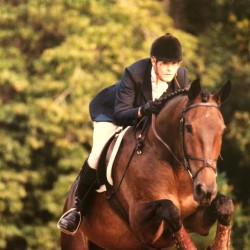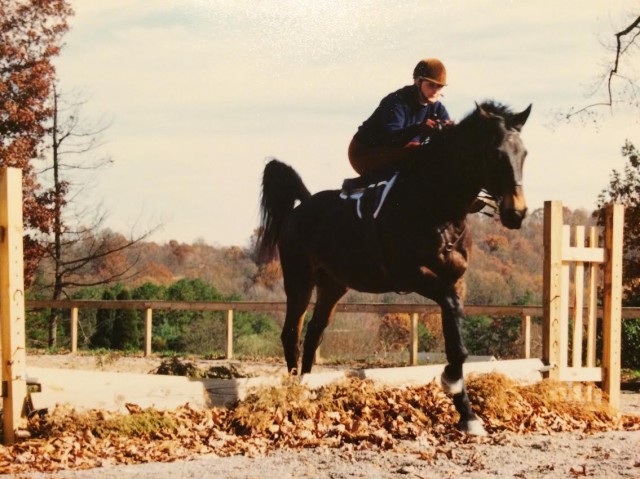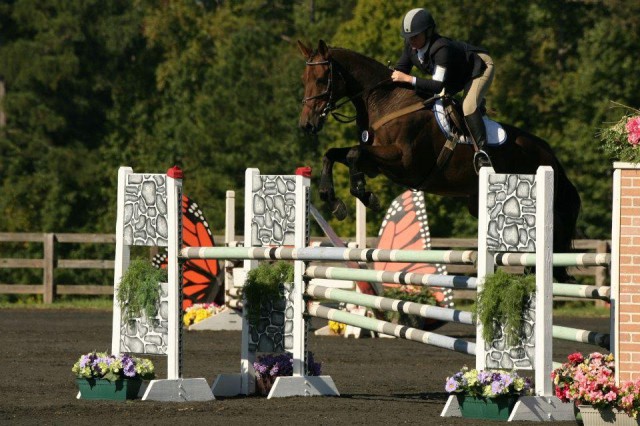There are so many event horses out there who, while they may not have quite made it to Rolex or the Olympics, deserve to have their stories told. Honoring these special equines is the premise of our “A Tribute to the No-Name” series, dreamed-up by East Tennessee eventers Erika Adams and Katherine McDonough. Today, Mary Sue Younger shares the story of Easy Does It ("Kidd") with the assistance of narrator Erika and Katherine.
I’m willing to bet that someone reading this article right now took their Pony Club ‘A’ on Kidd. And if you didn’t take your ‘A’ on Kidd, you prepped for it on him like I did. Kidd was the man, the professor. But little did we all know, long before he held our hopeful hands as we worked toward our ‘A’, that Kidd had his own rich stories to tell.
In 1974, Mary Sue Younger was 30 years old and living in Virginia when a friend of hers showed her a plain brown Thoroughbred/Percheron colt in a back field. He was about seven months old and had had very little handling by humans. Saying she was unimpressed by him would have been an understatement.
“I don’t know why I bought him really,” Mary Sue admits. “He was young and feral and not used to people and, honestly, not very pretty. But something made me buy that horse.” He didn’t have papers. He didn’t have a name. But for whatever reason, she stuck with her gut, loaded him up, and prepared to move to Tennessee.
She paid $150 for him.
When she arrived in her new home at Penrose Farm in Knoxville, TN, the colt still didn’t have a name. The people around the barn started calling him “The Kidd” since he was the baby on the farm, and the name stuck. And so Kidd spent several years growing up out in the field and mastering the art of being impossible to catch.
Mary Sue had done exactly one event prior to her relationship with Kidd. Her previous mount had succumbed to navicular disease, so she decided it was time to do something with The Kidd. She trudged out into the field to catch him equipped with a bucket of his currency and a prayer.
After pulling his mane, clipping him up, and giving him a bath, Mary Sue took a step back to see what she had in front of her. Her rogue, little, common-looking colt had turned into a lovely young horse. She settled on the show name of “Easy Does It.”
Mary Sue and Kidd set out to take on eventing, learning together, teaching each other, and becoming competitive, winning accolades along the way. As they began winning at Novice, people around her started to take notice of the plain brown horse. However, he wasn’t a point-and-shoot three-phase horse… yet.
For example, Kidd and Mary Sue competed Novice at the Middle Tennessee Pony Club Horse Trials where Jimmy Wofford was judging the dressage. “He gave us straight 5s on that test,” she recalls with a chuckle. “No higher; no lower. I didn’t know what I was doing, you see. I didn’t know how to put a horse on the bit. So, often, he wasn’t.”
When I ask her how she finished at that show, she looks at me with surprise: “Oh, we won. But it wasn’t so much about dressage back then. Kidd was better at the jumping.”
Pretty soon they moved up to Training where they dominated. But unlike Training, the move up to Preliminary was an unplanned one. Mary Sue was walking the Training cross-country course at the Flat Creek Horse Trials when she suddenly felt that the level was too easy.
So she walked the Prelim course and thought, “Well we can do this.” She found the show secretary and asked if they could switch divisions and move up to Prelim right then and there (#oldschoolforthewin).
Kidd and Mary Sue came away from their first Prelim outing with just time on cross-country and a 5th place ribbon. “So then, we went Prelim. And we didn’t look back,” she muses. As their dressage education evolved, they went on to place 5th and 6th at CCI*s only accruing time faults on Phase B, for Kidd was too much of a gentleman to take the bit and run over the steeplechase fences.

Mary Sue and Easy Does It tacking a hay feeder (which, with that crazy false groundline, would never make it onto a cross-country course today!) at Midland H.T. Photo courtesy of Mary Sue Younger.
- Photo courtesy of Mary Sue Younger.
- Photo courtesy of Mary Sue Younger.
- Photo courtesy of Mary Sue Younger.
- Photo courtesy of Mary Sue Younger.
- Photo courtesy of Mary Sue Younger.
- Mary Sue and Easy Does It after a win at Midland H.T. Photo courtesy of Mary Sue Younger.
Now, I could bore you with a list of Kidd’s triumphs with Mary Sue (like ETHJA Lifetime Achievement Award, Top Five Prelim Horse of the Year, back-to-back Adult Team Champion and Reserve Champion, etc. etc.). But there’s more to Kidd than being an accomplished event horse.
Mary Sue got involved with the Tennessee Valley Hunt and Kidd was quickly named Hunt Horse of the Year.
She jumped side saddle for funzies.
She entered an endurance race (#whynot). At this race, the show vet advised her to “take it easy.” He explained that only the little Arabs and thoroughbreds were competitive in these types of events and that she and her big warmblood didn’t stand a chance.
Kidd and Mary Sue came in second.
By 1994 Kidd had long retired from Prelim competition. Mary Sue had handed the reins of her beloved horse to her husband, Jim, who had never sat on a horse before. Kidd took him through Training, which included a win a Cahaba — an event that Kidd won with Mary Sue many years earlier. But that year, his golden reputation was transformed into true celeb status.
In 1994 riders in Florida were putting on charity horse show to benefit the children of Immokalee. They decided that the event would feature every kind of division, including a “Master Olympian” division. Here, former Olympic riders who were no longer competing rode on borrowed horses at the Training level.
One of these riders was Major General Jonathan R. Burton. General Burton was not only a two-time Olympian (show-jumping in 1948 and eventing in 1956), but was in the U.S. Cavalry and was one of the forefathers of the sport that us civilians are now able to enjoy. Kidd’s reputation preceded him, and Mary Sue was contacted to see if she would allow Kidd to be General Burton’s mount for the event. She was delighted and Kidd and Mary Sue made the trek to Florida.
“I was nervous as hell that he wouldn’t be good for General Burton. But of course he was! He was Kidd!” Finishing third the first year prompted a repeat performance from Kidd and General Burton the following year.

General Burton’s team at Immokalee in 1995, from left to right: Michael Page, General Burton, Karen Stives, Kevin Freeman. Photo courtesy of Mary Sue Younger.
As Kidd got older, he became a brilliant professor – a true teacher for eager riders. Kidd had an amazing ability to size-up his students.
“It was uncanny how he knew [what to do with his riders]!” Mary Sue recalls. He seemed to know who was on him and what that rider could handle. He knew when to take care of his rider and when to make him or her work for it. He knew when to hold your hand, and when to let go.
“And he earned his ‘A’ about a dozen times,” Mary Sue says with a grin. Penrose Farm hosted many ‘A’ Ratings and everyone— from national examiners to the candidates — knew who Kidd was. Kidd became the horse riders wanted to take for their ‘A’, the horse you wanted for your swap ride.
Kidd had evolved from a feral runt to a respected master. But Mary Sue never lost sight of what she saw in that no-name colt that day in Virginia. “He was just a good old honest horse,” Mary Sue reminisces, “and he was hard to catch ‘til the day he died.”
Kidd may have been just a brown horse, plainly bred with a common head who was anything but plain or common. He was wise and he was cheeky. He was diplomatic and he was forgiving. He was independent, but the consummate team player. Kidd was the perfect teacher – if you could catch him.
Kidd, this one’s for you.
Thanks to Mary Sue for sharing Kidd’s story and to Erika Adams and Katherine McDonough for their assistance in writing it. Does YOUR special horse deserve to have its story told? Email it to [email protected] for inclusion in a future edition of “Tribute to the No-Name.”






































